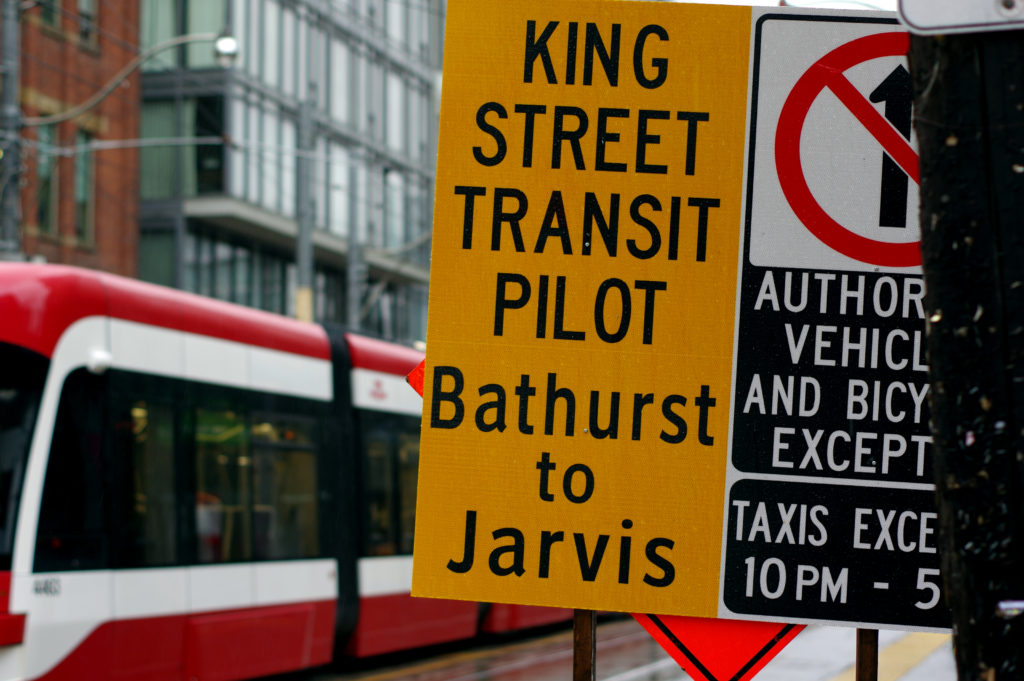A query from an Ombudsman Investigator reveals that the King Street Pilot proposal to council misled with a false comparison and a lack of vehicle data.
With the King Street Pilot Project having recently reached its year-end close, Toronto’s City Council will now be making a decision on whether the project will continue into perpetuity. Since its launch, much of the press extolled the benefits of the project, continuously citing improved commute times (with little or no collateral damage elsewhere) as reasons for its success and longterm viability.
However, the seemingly foolproof project needed new patio space to quell the ire of many business owners; new public spaces; artistic installations (at additional costs); discounts for customers through an app called Ritual; and the support of the ‘King For All’ coalition—a band of transit activists, business and local residents’ associations—to adorn, enhance and keep the project on course. Articles regarding spiked ridership were sewn into the local broadsheets, but for the most part, thorough examination of the dashboards were never made; they were mostly echoed for their highlights as illustrated from their easy-to-swallow infographics. In short, it’s been a war of public perception from the start.
Nonetheless, even the most banal of projects can produce changes that create unfavourable consequences, some of which trigger a person to action. Jesse Warfield, business owner of District Eatery, located on King Street—at the heart of the pilot zone—is one such person.
As a business owner, Warfield has good reason to keep tabs on whatever changes occur in his area; however, after stumbling upon articles that unpacked the City’s data—showing pre-pilot data to be inconsistent with what was being purported—Warfield grew more concerned over the possibility of duplicitous behaviour regarding the pilot’s proposal to council.
Loaded with data from the City and two AlgorithmicCulture/AlgoPress articles (1,2), Warfield set a course for the Toronto Ombudsman. He filed a complaint in hopes to get answers to an allegedly egregious discrepancy regarding pre-pilot data; seeking transparency from key members of Toronto’s Transportation Services. Warfield feels that what’s been presented to the public—specifically what was proposed to council—was a lie tantamount to an abuse of power, from those who knew they had insufficient data but moved ahead with the pilot regardless; devising a 3:1 comparison of transit to vehicle data that would later influence council’s vote. Warfield, expecting municipality to conduct themselves ethically, is also seeking answers as to how supposed disregards can be made without repercussion.
___________________________________________________________________________________________

___________________________________________________________________________________________
Warfield’s complaint was that the pilot proposal to council had a glaring problem in what it claimed when comparing streetcars and vehicles: data for streetcar commuter counts were collected from 14 kms of road whereas vehicle passenger counts were just from one intersection. The artful result as presented in the proposal was a 3 : 1 ratio. In assessing who used the King route more, this created an imbalance that weighed in favour of making changes for transit, as transit passengers were in the majority of those compromised in their daily commutes. In essence, private vehicles were the major culprits of traffic, and since they were in the supposed minority as presented in the proposal, only their commutes would be compromised to create transit efficiencies with the proposed pilot. This leaves one to wonder, that if vehicle passengers were in the majority of commuters along King Street in an all-day count, where was the pilot to benefit them or all members of the road?
___________________________________________________________________________________________

___________________________________________________________________________________________
Mr Warfield filed his complaint in the summer and waited as the investigators made their way through reams of data to assess whether there was a case to be made for an official enquiry. What Warfield hoped to relay to the Ombudsman was the severity of his complaint, that this was not some minor blunder to go unnoticed.
“This is about whether our municipal members are exercising their power with honesty or whether they’re abusing it.”
Furthermore, the delicate rebuke from the Investigator to the department of Transportation Services would also include an admonition: to ensure that Transportation Services commit to presenting data with more clarity moving forward. Warfield is perplexed that his complaint returned an apology, one that he says should be directed to all of Toronto, but specifically council.

________________________________________________________________________________________
For Warfield, the Investigator’s reproach was the equivalent to a finger wag as opposed to an official enquiry for which he still seeks. The entire premise for the pilot was addressed in the comparison (the faulty ratio), one that in the end was a gross displacement of data representation; however, it seems data wasn’t at all the issue or the focus. In their summation, it was more about the improper use of language, as suggested to Warfield via email; a member of Transportation Services acknowledged that it was clarity of language that failed to represent data accurately. According to both the Investigator and Transportation Services, the issue of fudging numbers seems to alternate with the fudging of language, as an innocent, harmless slippage.
Mr. Warfield is perplexed to see his complaint reduced to the fault of ‘language’ in the reply, as it conceivably excuses the principal players of responsibility for inaccuracies that may have been deliberate or for simply proposing a pilot with inept representation of data. Warfield doesn’t imagine an oversight—an error of this kind in a private financial enterprise, for example—being written off so easily because of language issues. “When you create a false ratio from numbers, it isn’t language that’s the problem, it’s the data” suggests Warfield.
In our view, however, the way these numbers were used in the staff report and the presentation was not sufficiently clear. —
Investigator for the Toronto Ombudsman to Warfield in their response to his complaint regarding King Street Pilot proposal.
‘We acknowledge in hindsight that the language was not clear enough in explaining what each of these figures represented. […] Again, we offer apologies for the prior lack of clarity on the significance of these figures and appreciate the opportunity to respond.’
— Representative for Transportation Services
“It’s not me [Transportation Services] should be apologizing to, they should apologize to all of Toronto, and specifically to city council. They misled with their proposal, skewing perception with an inaccurate comparison.” — Jesse Warfield
A critical discovery from Warfield’s complaint is that it reveals a truth about the proposal from Transportation Services. It shows they were aware that they lacked data regarding how many cars traversed along the entire 504 route by including a count from one intersection as sufficient representation, and yet it was incorporated into the proposal regarding a 14 km route.
One intersection compared to 14 kms of road is an apples-to-oranges comparison. It becomes no surprise then that City Council—seeing the optics of a drastically imbalanced comparison presented to them—voted in a majority for the King Street Pilot. Had council been initially informed through clear and proper use of ‘language’, they would have been told the following truths according to the City’s own data: during peak hours, inside the pilot zone, the ratio of vehicle to transit riders is significantly closer to each other and that outside of peak hours, vehicle riders outnumber transit riders by a considerable margin. (1,2)
Warfield believes that the pilot is more about the perception of success than whether or not the project is actually a success. With peak hours seeing minuscule improvements for many streetcar commuters and with little focus placed on traffic along neighbouring roads that have resulted in increased commute times for drivers, it’s easy to see his cynicism.
Warfield, compelled after reading articles that unpacked pre-pilot data, sought the authority of the Ombudsman to inspect any possible breaches of civic trust, but most of all, wants to bring transparency and accountability to City Hall.
Mr. Warfield is disappointed with the current outcome of his complaint and awaits a response from the Ombudsman as to whether they will continue with a formal enquiry into the matter. With his initial complaint and file closed, he is pushing for them to uncover the full severity of the false claims made to council regarding traffic on the King line, and wonders why they haven’t already with evidence and an admission of misconduct, whether it be in the form of ‘language’ errors or otherwise. In the meantime, he wants Toronto, and specifically Toronto City Council, to understand that pre-pilot data was misused and improperly presented, possibly having swayed and manipulated its vote.
________________________________________________________________________________________
COMMENTS
We Want To Know—Leave Your Comments Below
Should the pilot have launched on these grounds, and is traffic, and frustrating commute times for all citizens in certain areas a mere consequence of living in a city with dense population—particularly with no adequate subway system to alleviate congestion?

